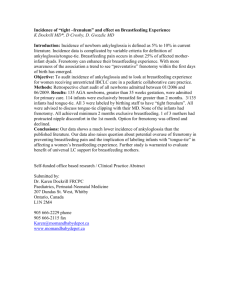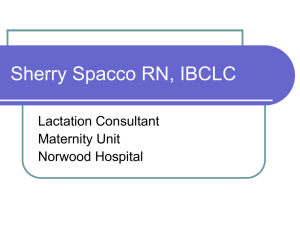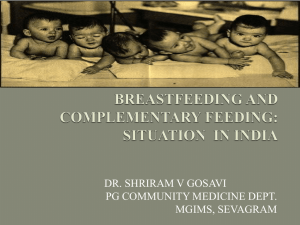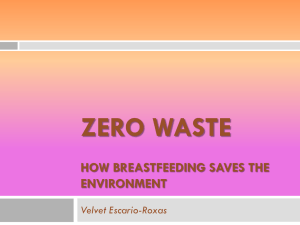Microsoft Word - UWE Research Repository
advertisement
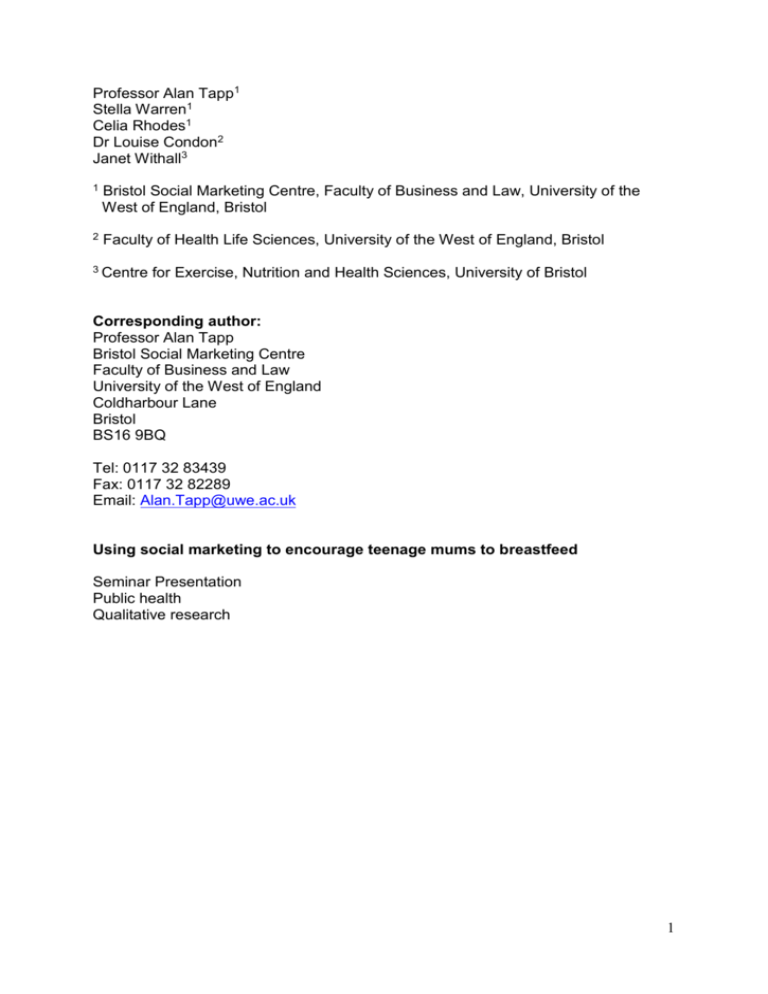
Professor Alan Tapp1 Stella Warren1 Celia Rhodes1 Dr Louise Condon2 Janet Withall3 1 Bristol Social Marketing Centre, Faculty of Business and Law, University of the West of England, Bristol 2 Faculty of Health Life Sciences, University of the West of England, Bristol 3 Centre for Exercise, Nutrition and Health Sciences, University of Bristol Corresponding author: Professor Alan Tapp Bristol Social Marketing Centre Faculty of Business and Law University of the West of England Coldharbour Lane Bristol BS16 9BQ Tel: 0117 32 83439 Fax: 0117 32 82289 Email: Alan.Tapp@uwe.ac.uk Using social marketing to encourage teenage mums to breastfeed Seminar Presentation Public health Qualitative research 1 Abstract This paper reports research which investigated ways in which teenage mothers could be encouraged to breastfeed. Social marketing strategies may be of limited effectiveness in countries or cultures where attitudes to breastfeeding are more positive, but in the UK, health professionals recognise the importance of winning the battle for the hearts and minds of young mothers to encourage them to breastfeed. Among the limited number of qualitative investigations into the lived experience of mothers and their infant feeding decision-making processes, very few direct specific focus on adolescent mothers and this paper seeks to address that gap. The decision to breast or bottle feed is not a high priority for most teenage mums. Although the health benefits of breastfeeding are accepted, these messages are not seen as a strong motivator by this age group. Breastfeeding is a rather ‘low involvement’ decision for most teenage mums which implies that if breastfeeding became ‘the norm’ few would challenge this. Social marketing strategies can be deployed as a valuable component within successful clinical pathways to encourage breastfeeding amongst teenage mothers by creating a social norm, focusing on support and benefits from the mother’s perspective and as a way of thinking that influences health professionals. 2 Introduction The Bristol Social Marketing Centre conducted research to investigate how best to encourage breastfeeding amongst adolescent mothers. UK rates of breastfeeding are low generally when compared internationally and among teenage mothers the problem is particularly acute. A literature review was commissioned by a UK based health organisation which found that breastfeeding behaviours can be influenced by a complex set of factors. Further study was seen as necessary, leading to the commissioning of the authors to conduct a detailed qualitative exploration of the possible role of social marketing in encouraging breastfeeding amongst teenage mothers and in this paper, we report on the key findings. The qualitative work suggests a simplified Theory of Planned Behaviour (TPB) as useful way of explaining the major influences on breastfeeding. This was used to structure a solution that highlighted three strategic priorities of social marketing based on the TPB’s three components: changing attitudes, altering social norms and increasing confidence. The study and its findings In total, 58 respondents participated in face-to-face interviews or groups conducted with pregnant teenagers and young mothers, their mothers, young fathers, and professionals working with young mothers to explore feeding decisions and to examine social marketing options. The fieldwork followed an extensive literature review which fed existing campaigns and ideas into the topic guides to prompt discussion and was completed between March-July 2009 Given the emergent nature of the data no hypothesis or structures were applied and no preconceived theory tested, letting the voices of the participants be heard. 3 Our research began by listening to the lives of the young women in order to understand the wider context for breastfeeding. At the age of conception, they had typically undergone a transitional period between childhood and adulthood, during which, as well as their physical bodies, their emotions, hormones, judgement and identity were in flux. Not surprisingly, breastfeeding was seldom on the radar of everyday life for our respondents. When asked, a shrug of shoulders suggested little difference in their minds between breast and bottle feeding. For them, much bigger issues revolved around where to live, the position of the partner in their lives, getting financial and emotional support and, in some instances, continuing a self-centred teenage life. In this complex context, there was typically no commitment to breastfeeding leading to a feeding decision immediately after giving birth, taken without much thought or care, often seemingly impulsive and based on how they felt at that moment. We also found that respondents were at a stage where they felt a sense of frustration at having relatively little control over their lives but with breastfeeding one of the few areas in which they could make a choice that was theirs and theirs alone. An expert led or authoritarian approach was likely to lead to defiance and to reverse this it was important that the mothers were given a sense of control over their choices, something social marketing designs are well placed to do. Of the breastfeeders interviewed, the pain, exhaustion, difficulty with the sole responsibility and time consuming nature of breastfeeding together with the other stresses of the time seemed very genuine. These young women had not yet had sufficient experience of life to be able to ‘tough things out’, to soldier on in the face of difficulties. They were fragile in their day to day decision making and tended to be short-termist in their thinking which has implications for the vital area of support. 4 Our methodology precluded us from making quantitative judgements, but we found encouraging signs that during pregnancy and immediately after birth the message that ‘breastfeeding is healthy’ appeared to be getting through. However, although they could recite the basic facts back, this did not mean the teenagers had formed an emotional connection with the information, or ‘internalised’ it as being relevant to their own personal beliefs. Also, we found only a limited knowledge of the physical health benefits that accrued to mothers as a result of breastfeeding and very little discussion of any emotional benefits. For some of the youngest girls, breastfeeding aroused an instant primal cringe – a biological response of revulsion. This (immature) inbuilt response is typical of teenage mentalities where their brains have yet to catch up with the biological realities of being a mum; they haven’t had enough life experience or exposure to ‘messy’ bodily fluids. In sum, there seemed to be a classic instance here of raising awareness being far from the same as creating motivation to act. This was also illustrated with the high drop off rates for breastfeeding beyond initiation in the hospital, something of concern to the Trust. The strategic uses of social marketing The Theory of Planned Behaviour (Ajzen, 1985) emerged as a key model to explain the use of social marketing to encourage breastfeeding. Our exploratory work highlighted self-interest (outcome expectancy attitudes); social norms and perceived behavioural control (confidence to act) as important themes that could guide subsequent social marketing design. Hence, there are three key areas where social marketing can be used strategically. Firstly, to focus on the personal benefits of breastfeeding to the mother; secondly, to help create and sustain a societal norm to breastfeed; and thirdly, social marketing inspired ‘ways of thinking’ (empathy for the teenage mum and her motives) to re-design some aspects of front line support for 5 breastfeeding and guiding health professionals in their service delivery. The diagram below expands on these strategies, illustrating where they may fit against a ‘timeline’ of ante- and post-natal activity. INSERT DIAGRAM HERE The first task would be to pinpoint new attitude creation that could generate motives to breastfeed. Generating new attitudes The interviews revealed that the adolescent mums were typically still teenagers first and mums second. This suggested that any approach to breastfeeding should maintain a strong focus on benefits to the mother. Put simply, motivated by selfinterest, they will ask: “I understand breastfeeding is good for the baby, but what’s in it for me?” Appeals based on the health belief model fell, to some extent, on deaf ears and this suggests a better approach would be to rebalance baby and selforiented benefits towards self. This fits the social marketing ‘exchange’ concept very neatly: a proposition is made to the mother of some kind of reward in return for breastfeeding, so social marketing appeals to their self-interest. In many public health sectors, an individual’s behaviour is only indirectly linked to a subsequent health benefit. We may exercise regularly, but many of the health benefits are not immediate and tangible – they are longer term, diffused, vague and cannot be linked directly to the exercise we did years previously. The same is true of breastfeeding – the health benefits to the individual or their baby are, in their minds, a leap of faith, a trust in a health message they have received. Commercial advertisers seek to overcome this lack of tangibility through creative approaches that 6 ‘artificially’ make health benefits tangible and visible through visual cues. A UK example may be the adverts for the antacid Gaviscon, using a visual metaphor of cartoon firemen to depict the calming action of the product. Creating a social norm and instilling confidence and control The Trust was already undertaking action in the area of normalising breastfeeding in public places. ‘Breastfeeding Welcome Here’ signage in retail based restaurants was an example. Recommendations were made to increase such work, while clamping down hard on illegal discouragement of breastfeeding still sometimes found. The research prompted the Trust to consider a unique clinical pathway for teenage mothers, with special procedures to emphasise the importance of enhanced support for breastfeeding. Peer-based support in which the young women could relate to someone close to their age was seen as an important tactic. Conclusion Teenage mums are a special category. They see the world through a teenager’s eyes: self absorbed, sometimes defiant, sometimes intimidated by life, trying to define their role in the world (Elkind, 1967; Grady and Bloom, 2004) and teenage breastfeeding support needs to fit into this picture. Social marketing is about seeing the world through the eyes of our audience; paying attention to their motives. Programme design should be strongly influenced by these considerations, as much as, or more than, by clinically-led approaches. Hence, the overall process – policy, structure, support and interventions are all influenced by the mindset and lifestyle of the young mother. 7 Diagram Three roles of social marketing mapped to the timeline of breastfeeding Work on changing Social Norms Market to Family / personal support Inject social marketing into support services Focus on benefits of BF Early pregnancy Birth Plan Labour Birth st 1 Feed Subsequent feeds in hospital Go home 1st feeds at home 1st Hour 8 References Ajzen, I. (1985). “From intentions to actions: A theory of planned behaviour”. In J. Kuhl & J. Beckmann (Eds.), Action-control: From cognition to behavior (pp. 11-39). Heidelberg: Springer. Elkind, D. (1967). Egocentrism in adolescence. Child Development, 38, 1025-1034. Grady, M. and Bloom, K. (2004). Pregnancy outcomes of adolescents enrolled in a Centering Pregnancy Program. Journal of Midwifery and Women’s Health. 49 (5):412-419). 9

